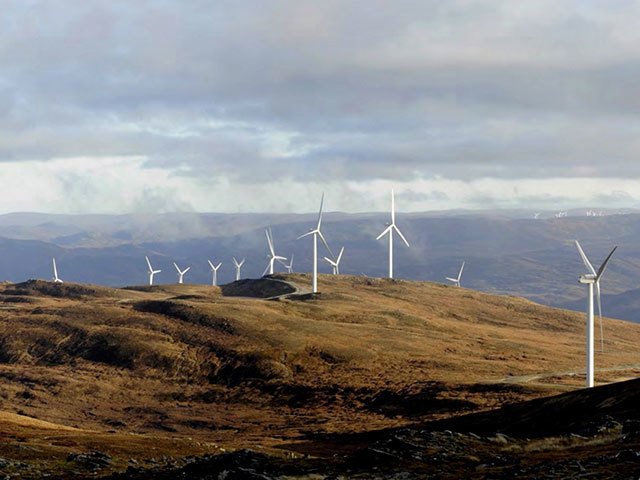
Plans to end subsidies for new onshore wind farms will push up energy bills and could face judicial review, the Government has been warned.
Energy Secretary Amber Rudd has unveiled proposals to close the existing subsidies payment schemes a year early for new onshore wind projects, to fulfil a Conservation election manifesto promise.
The Tories claim the onshore turbines “often fail to win public support and are unable by themselves to provide the firm capacity that a stable energy system requires”.
But the industry and environmental campaigners have criticised the Conservatives for attacking the cheapest form of clean energy, and one which enjoys the support of 65% of people, while saying they want to cut carbon in the most cost-effective way.
It will push up energy bills, as support will have to go on more expensive forms of low-carbon energy to meet targets to tackle climate change, they warn.
The move also leaves thousands of jobs and millions of pounds of investment hanging in the balance, the industry said.
And it has prompted an outcry in Scotland, where the majority of the planned new wind farms will be constructed, with Scottish Energy Minister Fergus Ewing MSP saying he has told the UK Government the decision may be the subject of a judicial review.
Industry body RenewableUK chief executive Maria McCaffery said the decision to prematurely end financial support for onshore wind sent a “chilling signal“ not just to the renewables industry, but to all investors right across the UK’s infrastructure sectors.
“It means this Government is quite prepared to pull the rug from under the feet of investors even when this country desperately needs to clean up the way we generate electricity at the lowest possible cost – which is onshore wind.
“People’s fuel bills will increase directly as a result of this Government’s actions.
“Ministers are out of step with the public, as two-thirds of people in the UK consistently support onshore wind.
“Meanwhile the Government is bending over backwards to encourage fracking, even though less than a quarter of the public supports it, ” she said.
Under the plans, the “renewables obligation” scheme, through which subsidies are paid to renewable schemes, will be closed to onshore wind farms from April 1 2016.
There will be a grace period offered to projects that already have planning consent, a grid connection offer and acceptance and evidence that the scheme has the right to use the land.
This could allow up to 5.2 gigawatts (GW) of wind capacity to go ahead – potentially leading to hundreds or even thousands more wind turbines going up in the countryside across the UK.
The renewables obligation has been closed to large scale solar farms, amid Tory concerns that the technology was a blight on the landscape, and is due to close to all new renewables schemes in 2017, when it was expected to end for onshore wind.
A new system for subsidies for low carbon energy, known as “contracts for difference” is being brought in, and it is not clear whether new onshore wind farms will be eligible for the scheme in the future, though it is believed to be unlikely they will.
More than £800 million of subsidies – which are paid for through consumer bills – helped onshore wind generate 5% of the UK’s total electricity last year, the Department of Energy and Climate Change (Decc) said.
Ms Rudd said there were enough subsidised onshore wind schemes to meet renewable energy commitments.
But a European Commission progress report this week suggested the UK was one of several member states set to significantly miss its renewables targets for 2020 and would “need to assess whether their policies and tools are sufficient and effective in meeting their renewable energy objectives”.
Ms Rudd said: “We have a long-term plan to keep the lights on and our homes warm, power the economy with cleaner energy, and keep bills as low as possible for hard-working families.
“We want to help technologies stand on their own two feet, not encourage a reliance of public subsidies.
“So we are driving forward our commitment to end new onshore wind subsidies and give local communities the final say over any new wind farms.”
Moves have also been announced which will mean that local communities will have the final say on large wind farms in England and Wales, although it will not affect Scotland where most of the new large scale schemes are planned.
The subsidy changes will apply to Scotland, where Mr Ewing said the decision was “deeply regrettable” and would have a disproportionate impact on Scotland as around 70% of onshore wind projects in the UK planning system are in the country.
“This announcement goes further than what had been previously indicated. It is not the scrapping of a ’new’ subsidy that was promised but a reduction of an existing regime – and one under which companies and communities have already planned investment.
“Onshore wind is already the lowest cost of all low carbon options, as well the vital contribution it makes towards tackling climate change, which means it should be the last one to be scrapped, curtailed or restricted.”
And he warned: “The UK Government have chosen to place at risk a huge investment pipeline, conceived in good faith by developers based on statements from the UK Government.”
WWF Scotland director Lang Banks said: “This decision risks undermining the development of the cheapest form of renewables in the country, and is bad news for Scotland’s clean energy ambitions.
“Cutting support early for the lowest cost renewable technology is a backward step that will either see bills rise or climate targets missed.”
Recommended for you
